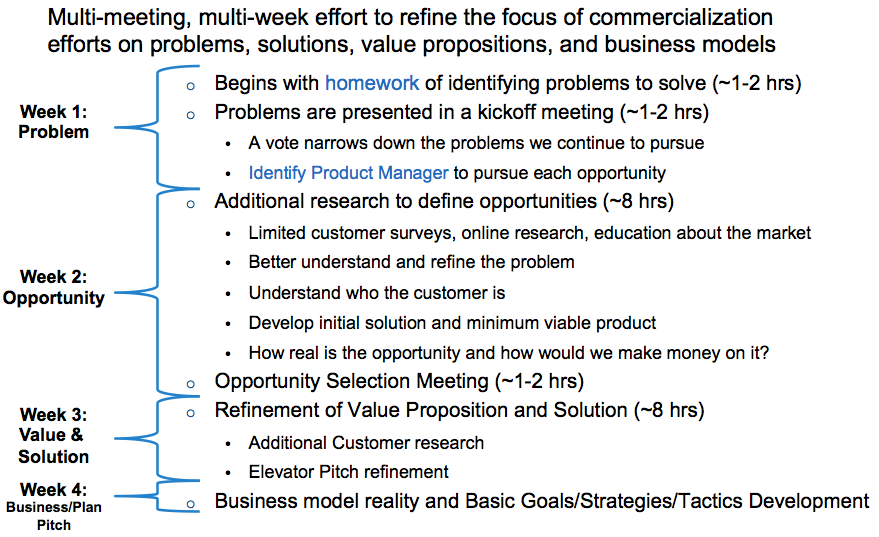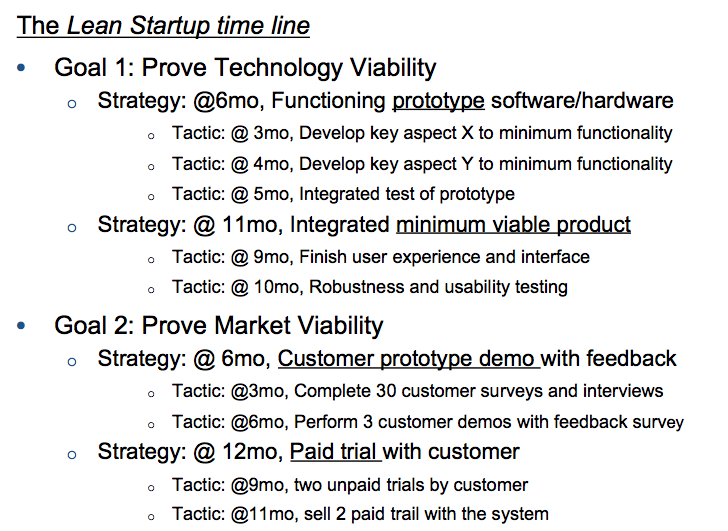Overview:
I have spent the past few years commercializing technology and establishing strategies for a new business. The following describes my thought process for generating a new product. This process is ideal for situations where there is IP, grant money, or another basis for technology (perhaps your skills and background in a particular area) that you want to bring to market. When combined with structured brainstorming, it is also very well suited to ‘blue-sky’ development of a new venture.
The goal is to identify business opportunities though a structured ideation, examination, and refinement. These opportunities will be evaluated with limited resources expended. To evaluate an opportunity you need to understand what problems a customer is concerned with, what they perceive as valuable, and how they value a solution to their problem.
You will need to focus externally, on potential customers, to successfully develop a product that will sell. You will need passion, skill, and a little luck to execute on the opportunity. The opportunity and the associated solution should align with your strengths and personal goals to maximize the chance of success.
Once the problem has been identified we can start to define our solution. It will take some iteration to simplify it and wrap a business model around it. You will have limited resources if you move forward so you need a refined minimum viable product(MVP) and a plan to get to it. This MVP needs to to deliver some value to the customer-base and should be the simplest form of the solution that can be deployed quickly and affordably.
The process is based on the ideas of multiple respected academics and industry professionals. Michael Porter’s 5-Forces and Value Chain serve as a foundation. My background being in aerospace, “Heilmeier Catechism“ provides additional questions to ask as you begin the product development process. Howard Stevenson’s framework for evaluating opportunities provides a structure to down-select the most optimal venture and strategy. The principals of the “Lean-startup” focus efforts on rapid proof-of-concept and proof-of-market to enable early revenue with minimal investment.
Blog Table of Contents
Customer Surveys and Problem Refinement
Refining Your Solution and Value Proposition
Validate Technology and Market
Problems Overcome Inertia:
No one likes change, it is disruptive. If it goes poorly the decision makers might be fired and if it goes well it requires more work and people are busy. A “nice to have” will never sell well for those reasons. Change is easier to make if it solves a problem a major headache in an organization. Solving a problem will get someone a promotion and a pat on the back. If they fail, people will be pleased they tried to fix the problem.
“But I don’t have a problem!?”
Alternatively an organization might not want to admit it has a problem, its culture may resist the implication they need a solution. A strong value proposition that can combat this preconceived notion is – making the customer more money! Find your customer more revenue, extend their product line, help them enter a new market. That will get their attention even if they say things are going perfectly.
To sell something you need to prove its value:
Customer pays $XX and gets solution YY in return. The impact of the solution needs to be quantifiable. We have to prove the solution will happen and provide the desired revenue, savings, etc. Initially interviews and surveys will help you understand the impact the customer wants from your solution, and how much pain in dollars the problem is causing (or how much additional revenue they want to see). Once your product is polished enough to be safe and not embarrass you, start offering free demos. I call this “pre-selling.” Early trials with important buyers who influence the market are a great way to gain exposure and validation. It is also important to move to paid trials rapidly. The customer has to value the solution more than they value the money they paid you for it and investors will want to see proof of that in early revenue.
The Process
Below is a basic roadmap for ideation, evaluation, and refinement of problems, solutions, and markets for new technology product opportunities.
The idea is this in turn leads to a 12-mo proof-of-concept and proof-of-market plan for the opportunity. This looks something like this:
In subsequent posts we will walk through each phase of this process using some examples. First, I find it good to think about how big an opportunity or market we should be going after. More on that here. Or if you prefer, move on to problem identification.
If this sounds like a lot and you are interested in some help, don’t hesitate to reach out! Through Integracer Consulting I help technology companies and investors achieve product/market fit.

